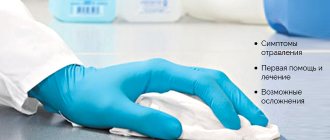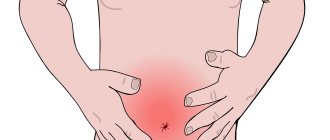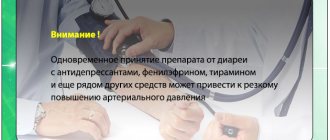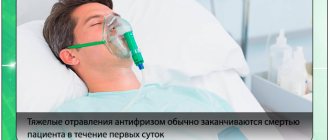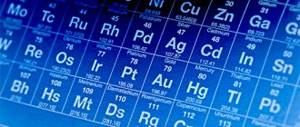A car is both a second wife and a man’s iron friend. She will always listen, will not judge, will not betray. Repairing a car or organizing “garage get-togethers” is more the prerogative of men than women. For this reason, men are more likely to become victims of car exhaust poisoning.
Therefore, for many car owners it will be useful to know the answers to the questions: under what conditions is intoxication with gasoline combustion products possible, what are its signs, and how can we help the victim? Let's find out, and at the same time learn about the treatment and consequences of car exhaust poisoning.
How it works?
Exhaust gas is almost always called carbon monoxide, familiar from school, which in chemical terminology is called CO. It appears where optimal conditions exist for its partial combustion.
During the combustion process, the flame has a characteristic blue color, but it does not have a pronounced taste or special smell. Due to the fact that the concentration in the surrounding air exceeds the norm, it turns into a compound dangerous to life and health. Intoxication occurs when a toxic concentration of gas enters the blood through the respiratory tract. This often occurs due to the vehicle's engine running indoors. For example, in the cold season in the garage.
Poisoning from car exhaust fumes is a deadly threat. If the victim is not provided with modern first aid, this will lead to a tragic outcome or disability in the future. The reason is that carbon monoxide, penetrating into the blood, binds to the protein of red blood cells. They are responsible for the ability to transport oxygen to the cells that need it.
Due to the reaction of gas and proteins in the body, a compound is formed that cannot contribute to the transport of life-giving oxygen into cells.
In addition, the harmful gas can also establish connections with a special respiratory enzyme, which as a result causes ischemia.
The speed of spread of toxic substances, as well as their degree of influence, is usually influenced by a number of additional factors, among which the following are highlighted:
- total gas concentration in a particular room;
- the intensity of the victim’s breathing during the intoxication period;
- room temperature;
- possible additional physical activity of the poisoned person.
Treatment for exhaust gas poisoning
What to do if you are poisoned by exhaust gases? Due to the high risk of pulmonary edema, you must immediately call an ambulance! Regardless of whether the victim is conscious, the person must be taken out into fresh air as quickly as possible. The patient must be provided with rest and warmth in order to save tissue oxygen consumption. Subsequently, the arriving medical team provides oxygen therapy. Through catheters inserted into the nasal cavity, 50–60% oxygen is supplied.
If symptoms of pulmonary edema appear due to exhaust gas poisoning, first aid boils down to the following.
- The patient is helped into a semi-sitting position.
- Tourniquets are applied to the limbs to reduce blood flow to the lungs.
- Injections of cardiac drugs (Strophanthin-K, Cordiamin), diuretics (Lasix), and decongestants (Prednisolone) are given.
- 40% glucose is administered; at the initial stage of poisoning, 10% calcium chloride is used.
Further treatment for car exhaust poisoning continues in the hospital. The ineffectiveness of the measures taken is an indication for artificial ventilation. For the purpose of detoxification, hemosorption is carried out. If there is no threat of pulmonary edema, saline solutions and glucose are administered intravenously, followed by stimulation of urination. Antibiotics are prescribed to prevent infectious complications.
Rehabilitation for severe exhaust gas poisoning takes a long time and involves sanatorium follow-up treatment.
Features of the classification of poisoning
In addition to the fact that exhaust fumes haunt all car enthusiasts in their personal garages, they can also be found in other places. For example, it has affected employees of indoor parking lots, as well as employees of transport service centers. If they do not adhere to safety regulations, then even small doses of inhaled exhaust on a regular basis can cause the onset of chronic diseases associated with the respiratory system.
Even residents of apartments located immediately above internal parking lots are in danger. This is typical for new multi-storey buildings.
Some car owners are unaware that even the inside of their car can be dangerous. Toxic gases can accumulate there to a significant extent if the vehicle does not have good ventilation.
If we take all these factors into account, it becomes clear that gas poisoning can vary greatly depending on where exactly it occurred and what impurities were in the dangerous composition. Often this is:
- carbon monoxide;
- Nitric oxide,
- hydrocarbons,
- heavy metals.
Each of the listed points has its own characteristic symptoms, effects on the body, and consequences.
Consequences of exhaust gas poisoning
The consequences of exhaust gas poisoning can be early or late. In the initial stages of the disease, there is a high probability of death from intoxication, and in the later stages - from pulmonary edema, cerebral edema, and severe pneumonia.
Long-term consequences boil down to the development of chronic respiratory diseases and oncological processes. The consequences can be so serious that disability may become a question.
The number of car owners is growing every year, so knowledge about the dangers posed by fuel combustion products will not be superfluous. Exhaust gases contain many substances that affect the body in different ways. The course of the disease depends on many factors and in each case can take a different turn. It is important to remember the danger of complications of poisoning and the threat of death, which is why it is so important to take precautions when working in the garage and not to be careless when the car engine is running. And if you suspect poisoning, seek medical help promptly.
Carbon monoxide
The main feature of this main component of exhaust gases is the ability to quickly interact with hemoglobin. At the same time, it is quite problematic to break established connections without the involvement of specialized equipment and medications.
Symptoms of exhaust gas poisoning, where only carbon monoxide predominates with a minimum amount of other components, are as follows:
- darkening of the eyes;
- pulsation in the temporal lobe;
- feeling drowsy.
In medical practice, there are three degrees of severity of intoxication. If you do not have time to provide emergency assistance to the victim immediately, this leads to an unconscious state of the patient with subsequent swelling of the brain tissue and lungs. The last stage of poisoning is called “gray” in professional slang because of the characteristic color of the skin and mucous membranes.
First aid
Saving the life of a victim directly depends on the speed of emergency care. All activities include:
- Removing the patient from the place of exposure to gases.
- Providing access to oxygen.
- Using ammonia if the victim was unconscious.
- Turning to one side in case of vomiting.
If you lose consciousness, it is important to pay attention to the state of your breathing and pulse. The absence of these indicators requires chest compressions.
You should not take the pills yourself. Other measures should be prescribed by a doctor.
Nitrogen oxides
Initially, the oxide has no noticeable color or odor. After NO (the chemical formula for such oxides) begins to actively interact with oxygen, its formula changes and is NO2.
The traditional “habitat” of a compound that has already been converted into dioxide is usually called any lowlands or pits (garage repair pits are a prime example of this). Once the dioxide hits a wet surface, it turns into nitric acid, which is deadly to all living things. It is this that negatively affects the mucous membranes of the respiratory tract.
The classic clinical picture of intoxication with a large proportion of nitric oxide is considered to be the following:
- cough,
- feeling of "lack of air"
- labored breathing,
- weakness,
- hoarseness.
This version of poisoning is more insidious, since it involves a latent period. This means that after the first manifestations of characteristic signs, the symptoms almost completely go away. This rule applies even to particularly severe cases.
And when a person thinks that he has already become much better, the next phase begins, which involves toxic edema not only of the larynx, but also of the lungs. All this manifests itself in:
- shortness of breath;
- bubbling breathing;
- increased cough with sputum, sometimes with blood;
- blue lips, ears, nose;
- general pallor;
- pronounced heartbeat.
But blood pressure readings may remain normal or show only slightly elevated readings. If pulmonary edema does occur, it is usually called “blue”, as it is accompanied by a bluish tint to all skin.
Symptoms
Symptoms of exhaust gas poisoning are varied and affect all vital systems of the body. In this case, the poisoned person experiences unpleasant sensations, which leads to a significant deterioration in well-being. Intoxication inhibits the functioning of the cardiovascular, respiratory and nervous systems. The severity of the manifestations depends on the individual characteristics of the victim (weight, gender) and the duration of contact with the toxic substance.
Respiratory system
Toxic damage to the respiratory function is the main symptom that worries a person during poisoning. The victim begins to breathe frequently and heavily, develops hoarseness and a sore throat. Sometimes a reflex cough or nasal voice develops due to swelling of the nasopharyngeal mucosa.
If a large amount of gas is inhaled, damage to the respiratory center of the brain, respiratory arrest and death are likely.
Nervous system
In case of exhaust gas poisoning from the nervous system, general cerebral symptoms prevail. These include:
- nausea, vomiting;
- disorientation in space, dizziness;
- decreased cognitive abilities;
- headache, shingles.
Excessively prolonged contact with carbon monoxide can result in loss of consciousness, coma, and even death.
Increased excitability or lethargy are typical signs of exhaust gas poisoning. With severe intoxication, tonic-clonic convulsions and impaired coordination of movements sometimes develop. In addition, one can note the appearance of visual or auditory hallucinations, short-term amnesia, and paranoia. This behavior causes certain difficulties when trying to help the victim. Inappropriate behavior sometimes leads to disastrous consequences both for the poisoned person and for those around him.
If the toxic substance begins to affect the lower parts of the brain (stem, cerebellum), then the clinical signs will be as follows:
- increased muscle tone of the lower extremities;
- mydriasis;
- convulsions;
- unsteady gait;
- the presence of pathological reflexes.
If the patient falls into a coma, dyskinesia may appear when consciousness returns. In some cases, inflammation of the nerve pathways (neuritis) develops. As a result, the victim’s hearing and vision are impaired, autonomic disorders and memory impairment appear. During a conversation, such a person may forget about what was said to him a minute ago, or may not understand where he is.
Hydrocarbons
A distinctive feature of the influence of hydrocarbons on the human body is chronic intoxication, which occurs even in cases where the dose is exceeded by a minimal margin. The toxic effect of hydrocarbons begins when incomplete combustion of fuel is observed.
The main signs of such poisons entering the body are:
- restless state
- drowsiness,
- dizziness,
- fainting,
- nausea.
With prolonged and constant exposure to hydrocarbons, the risk of developing cancer diseases increases significantly.
Treatment
After stabilization of the victim’s condition, as a rule, he is transported to the inpatient department. Specialists carefully study the symptoms, and treatment is prescribed based on this. Intoxication must be treated in combination, using infusion solutions, oxygen therapy and modern blood purification techniques.
- If there are signs of clinical death, the emergency rescue team begins resuscitation measures. When ventricular fibrillation of the heart occurs, defibrillation and administration of antiarrhythmic drugs are performed. If the victim does not breathe on his own, he should be intubated and then connected to an artificial respiration apparatus.
- If pressure drops, infusion therapy with 0.9% NaCl should be prescribed. In cases of severe hypotension due to developing shock, a dopamine solution is also used.
- The main antidote to carbon monoxide is pure oxygen. It is harmful to a healthy person, but the victim will experience a rapid improvement in well-being with oxygen therapy.
- Detoxification therapy can be carried out in a specialized toxicology department. Many toxic substances are removed from the body only using the hemosorption technique.
Lead and company
Lead, which is known for its negative effects on the body, often falls into the category of heavy metal compounds. Long-term exposure to heavy metals can result in:
- double vision;
- insomnia and irritability;
- difficulty swallowing;
- pain in the abdominal area;
- cognitive impairments.
The respiratory system is affected first, followed by the nervous system. Significant lesions overtake the circulatory system.
Prevention
It consists of several points. Recommended:
- Use filters in the muffler that delay gas emissions into the atmosphere.
- Do not turn on the machine when working in a home garage, or ensure rational air inflow and outflow.
- Monitor the condition of your car and the quality of the fuel used.
When entering a room with an increased amount of exhaust gases, you must use a gauze bandage. You can also simply cover your nose with a glove or other cloth.
What it is?
Exhaust gases are the result of fuel combustion during the operation of a car engine. Contains many substances of toxic origin, as a product of petrochemical oil refining. Owners of personal vehicles should pay special attention to this.
In this situation, the risk of death is high. It is important to quickly identify the symptoms of exhaust gas poisoning (ICD-10 code: T58). First aid will be needed urgently.
Composition of combustion results
Products from oil refineries always contain a variety of chemicals. Certain species are not harmful to the human body, while others pose a health hazard.
- Carbon monoxide (CO): disrupts the transport function of the circulatory system, interferes with the movement of oxygen (O2). The substance is colorless and odorless. This becomes the main reason why poisoning is noticed late.
- Nitrogen dioxide (NO2): has a yellow-brown tint and a special odor. At high concentrations it becomes suffocating. Hazard class – 3. Within 10 minutes. loss of smell occurs, severe dryness in the throat and irritability of the mucous membranes of the respiratory organs increase.
- Hydrocarbons (consist of hydrogen and carbon) have carcinogenic properties. A running machine is a constant source of such.
- Metals: contribute to intoxication of the body with constant exposure, causing disruption of sleep patterns, brain processes and feelings of anxiety.
- Aldehydes: cause irritation of the mucous membrane of the respiratory system and skin.
- Soot: The solid product of burning gasoline.
- Benzpyrene: hazard class 1. Interferes with DNA synthesis, which can lead to cancer.
Against the background of exhaust gas poisoning, an acute or chronic type of disease can develop. Symptoms indicate how long the exposure has been. It is recommended to reduce your time near a running machine.
A high level of accumulation of toxic substances is achieved during periods of negative temperatures. Cold air settles below. The worst situation in this case is the absence of wind.
How does poisoning occur?
Being near a car in a confined space poses a health hazard. A constantly running vehicle will produce exhaust gases that contribute to poisoning of the body.
Fuel combustion products will quickly fill the garage if the driver does not turn off the engine and close the door. Many cases of poisoning have been recorded in the work of mechanics, owners of cars with a defective ventilation system, and people living close to parking lots.
Slowly, toxic substances will begin to accumulate in the internal organs, destroying the body at the cellular level. There will be a disruption in performance and a complete stop of metabolism.
Factors influencing the degree of poisoning:
- High content of harmful substances in a confined space;
- Degree of absorption of polluted air;
- Temperature values (below 0 – high concentration);
- Human movement activity.
These factors contribute to the development of complications, preventing the body from quickly recovering.
Smog
Smog (Smog, from smoke - smoke and fog - fog) is a toxic fog formed in the lower layer of the atmosphere, polluted with harmful substances from industrial enterprises, exhaust gases from vehicles and heat-producing installations under adverse weather conditions.
It is an aerosol consisting of smoke, fog, dust, soot particles, and liquid droplets (in a humid atmosphere). Occurs in the atmosphere of industrial cities under certain meteorological conditions.
Harmful gases entering the atmosphere react with each other and form new, including toxic, compounds. In the atmosphere, reactions of photosynthesis, oxidation, reduction, polymerization, condensation, catalysis, etc. occur.
As a result of complex photochemical processes stimulated by ultraviolet radiation from the Sun, photooxidants (oxidizing agents) are formed from aldehydes and other substances.
Low concentrations of NO2 can create large amounts of atomic oxygen, which in turn forms ozone and again reacts with air pollutants. The presence of formaldehyde, higher aldehydes and other hydrocarbon compounds in the atmosphere also contributes, together with ozone, to the formation of new peroxide compounds.
Dissociation products interact with olefins, forming toxic nitroperoxide compounds. When their concentration is more than 0.2 mg/m3, condensation of water vapor occurs in the form of tiny droplets of fog with toxic properties. Their number depends on the season of the year, time of day and other factors. In hot, dry weather, smog is observed in the form of a yellow veil (the color is given by NO2 present in the air - droplets of yellow liquid).
Smog causes irritation of the mucous membranes, especially the eyes, and can cause headaches, swelling, hemorrhages, and complications of respiratory tract diseases. Reduces visibility on the roads, thereby increasing the number of traffic accidents.
The danger of smog to human life is great. For example, the London smog of 1952 is called a disaster, since about 4 thousand people died from the smog in 4 days. The presence of chloride, nitrogen, sulfur compounds and water droplets in the atmosphere contributes to the formation of strong toxic compounds and acid vapors, which has a detrimental effect on plants, as well as buildings, especially historical monuments made of limestone.
The nature of smog is different. For example, in New York, the formation of smog is facilitated by the reaction of fluoride and chloride compounds with water droplets; in London - the presence of vapors of sulfuric and sulfurous acids; in Los Angeles (California or photochemical smog) - the presence of nitrogen oxides and hydrocarbons in the atmosphere; in Japan - the presence of soot and dust particles in the atmosphere.
Other articles on the composition of exhaust gases
- Mixture formation in gasoline engines
- Stand with running drums
- Driving cycles
- ECE/EU test cycle
- US Federal Test Cycle
- Test cycle in Japan
- Test cycles to determine fuel consumption
- Engine Exhaust Gas Sampling
- Determination of fuel vapor emissions
- Methods for reducing exhaust gas toxicity
- Thermal afterburning
- Lambda probe - oxygen sensor
Catalytic converter
Car exhaust gas quantity
Mainly determined by the mass fuel consumption of cars. Distance consumption is standardized and usually indicated by manufacturers (one of the consumer characteristics). In relation to the total volume of exhaust gases coming out of the muffler, we can approximately focus on the following figure - one kilogram of burned gasoline leads to the formation of approximately 16 kilograms of a mixture of various gases.
| VAZ 2110 1.5k liter | VAZ 2110 1.5i liter | Mitsubishi Colt 5-D 1.1i liter | VAZ 11113 0.75k liters | VAZ 21055 1.5D liter | |
| Consumption in “urban” mode, l/100km | 9,1 | 8,6 | 7,0 | 6,4 | 5,7 |
| Consumption, uniformly 60 km/h, l/100km | 6,5 | 6,5 | 3,7 | 3,2 | 3,8 |
- k - carburetor engine
- i - injection engine
- D - diesel engine
- The density of gasoline at +20C ranges from 0.69 to 0.81 g/cm³
- density of diesel fuel at +20C according to GOST 305-82 no more than 0.86 g/cm³
Legislative regulation
- The quality composition
of manufactured and sold
fuel
(in Russia these are fuel standards, regional requirements, in Europe - EURO standards). - In Russia, increased rates of transport tax on
car engine power are being introduced. - Fuel is subject to special excise taxes
. - There are standards for manufactured cars
. In Russia and European countries, EURO standards have been adopted, setting both toxicity and quantitative indicators, for example: According to Euro-3 emissions: CH up to 0.2 g/km, CO up to 2.3 g/km and NOy up to 0.15 g /km - According to Euro-4 emissions: CH up to 0.1 g/km, CO up to 1.0 g/km and NOy up to 0.08 g/km
of heavy vehicles (for example, in Moscow).
Ways to reduce emissions and toxicity code
The incentive to reduce volumes is expected
interest in reducing fuel consumption (a major expense item in road transport).
- The organization of vehicle traffic
has a huge impact on the amount of emissions (not counting fuel combustion and time) (a significant part of emissions occurs in traffic jams and in front of traffic lights [
source not specified 2656 days
]). With successful organization, it is possible to use less powerful engines at low (economical) intermediate speeds. - It is possible to significantly reduce the content of hydrocarbons in exhaust gases, by more than 2 times, by using
associated petroleum (propane, butane) or natural
gases
as fuel , despite the fact that the main disadvantage of natural gas - a low power reserve - is not so significant for the city. - In addition to the composition of the fuel, toxicity is affected by the condition and tuning of the engine
(especially diesel - soot emissions can increase up to 20 times and carburetor - nitrogen oxide emissions change up to 1.5-2 times). - Significantly reduced emissions (reduced fuel consumption) in modern designs
with injection powered by a stable stoichiometric mixture of unleaded gasoline with the installation of a converter, gas engines, units with superchargers and air coolers, and the use of a hybrid drive. However, such designs greatly increase the cost of cars. - SAE tests have shown that an effective way to reduce emissions of nitrogen oxides (up to 90%) and generally toxic gases is by injecting water into the combustion chamber
.
Health risks if left untreated
At best, the patient will experience constant dryness in the chest and a burning sensation in the throat from constant inhalation of gas. Among the main consequences is pneumonia with a high risk of death. A strong cough is fraught with the threat of developing tuberculosis. The main cause of death is asthma attacks, which torment the patient all the time.

